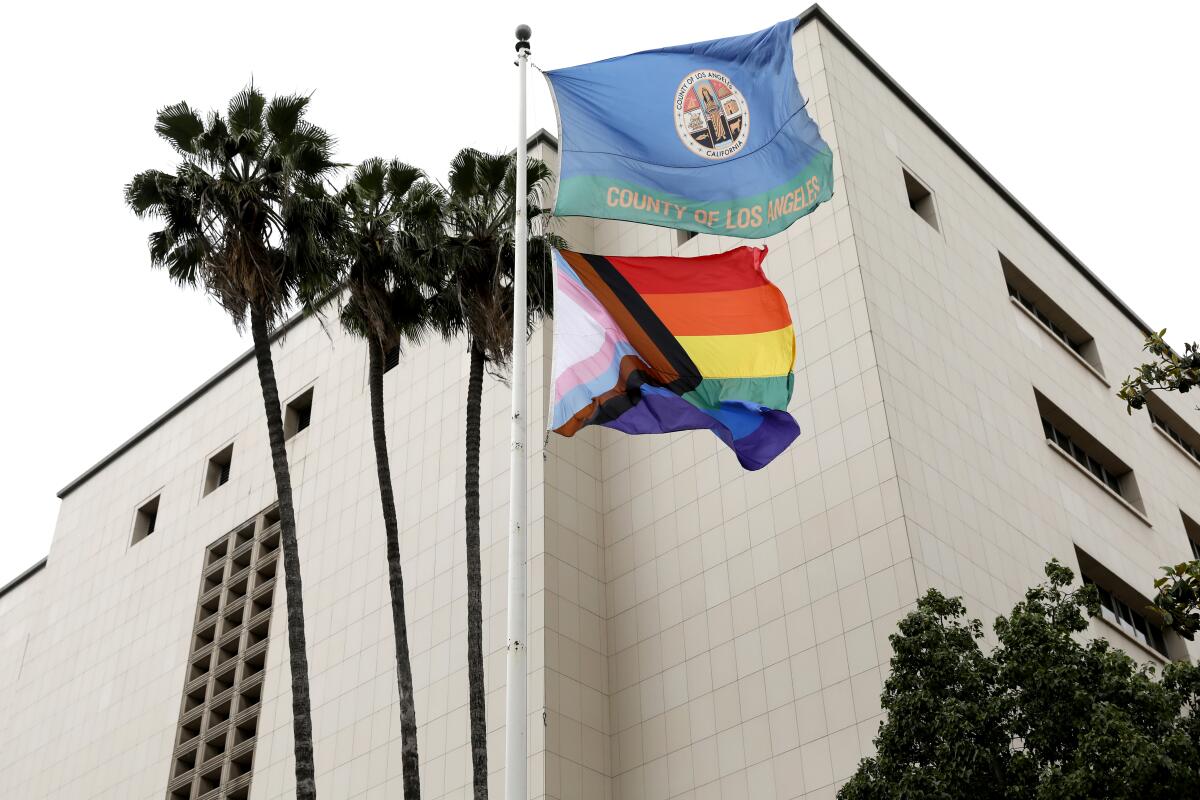LGBTQ+ residents flock to progressive L.A. County. But many can’t afford it, survey finds

- Share via
Most LGBTQ+ residents say that Los Angeles County is a welcoming place, but many don’t know if they can afford to stay, according to a county-commissioned survey by UCLA’s Williams Institute.
That a majority consider their hometown jarringly expensive is not exactly an unexpected finding for a survey in a notoriously costly region.
But Brad Sears, executive director of the Williams Institute, which studies sexual orientation and gender identity law, said he was startled to see fears over rising prices crop up again and again.
He said the survey, unveiled Tuesday as part of a 123-page report, asked point blank: If you could talk to a local official, what would you ask them to address?
The overwhelming takeaway from more than 1,000 LGBTQ+ residents: yes, discrimination is a concern, even in progressive L.A. County. But affordability of housing, food and other necessities weighed the heaviest on their minds.
The survey showed that LBGTQ+ adults were more likely than other L.A. County residents to have struggled with food insecurity and homelessness. They were also more likely to have experienced depression or attempted suicide.
“L.A. has always been this kind of beacon for the country,” said Sears. “What does it mean to keep drawing people here if they can’t afford to live here?”
The survey, which Sears said was the largest to gauge how the county’s LGBTQ+ residents are faring, used responses collected last year by the county Department of Public Health, with the survey authors conducting additional follow-up research.
The 1,006 respondents were considered a representative sample of the county’s roughly 665,000 LGBTQ+ residents. Two-thirds were people of color, 14% identified as trans or nonbinary and about two in five said they had a disability.
About one-third lived below 200% of the federal poverty level, which is less than $55,000 per year for a family of four, according to Sears.
Many wrote in their survey responses that they were having a hard time staying afloat. A gay white man in his 60s said he needed money “for a bearable retirement not fraught with worry.” A lesbian Latina in her 30s said her biggest concern was “not having a roof over [her] head.” For a gay Black man in his 50s, the biggest worry was “poverty and housing with black mold.”
“We do have a reputation for being an accepting place,” said L.A. County Supervisor Lindsey Horvath at a meeting Tuesday. “But our data makes clear that it’s becoming unaffordable for many people who want to come here into this safe place.”
The report found that one in three LGBTQ+ residents said their household struggled to find enough food in the last year, compared with more than one in five non-LGBTQ+ adults. And LGBTQ+ adults were nearly twice as likely to have been homeless in the last five years, according to the report.
For transgender and nonbinary people, the disparities were even starker.
The Williams Institute released a companion report, conducted with the TransLatin@ Coalition, which found that more than half of transgender and nonbinary L.A. County residents were living near the federal poverty line. More than a quarter of trans and nonbinary people were unemployed, compared with about 5% of L.A. County residents overall. About one in five trans and nonbinary people who had looked for housing in the last five years believed they had been rejected because of their gender expression.
Though affordability concerns loomed largest, the main Williams Institute report found that many LGBTQ+ residents fear being discriminated against.
Nearly one in 10 avoided calling police to avoid “unfair treatment.” One in five said they avoided public places, such as the park or the beach, in the last year for fear of being harassed. A woman said she was shot at with a paintball gun as she was leaving a gay bar on Sunset Boulevard while holding hands with her girlfriend. A nonbinary person said they were misgendered by a signature collector outside a grocery store.
“When I informed the person that they had misgendered me, the person responded that I was violating their political rights to free speech,” wrote the respondent. “It ruined the next few hours of my day.”
Barbara Ferrer, director of the county Department of Public Health, said this discrimination translated into “stark inequities” in the health outcomes of LGBTQ+ residents. More than a third of LGBTQ+ respondents said they have experienced domestic violence. One in 10 said they did not go to healthcare providers in the past year “for fear of unfair treatment.”
Speakers at the Tuesday meeting acknowledged that there were many reasons for the county’s LGBTQ+ residents to be concerned for their safety. Nationally, there’s been a dramatic rise in laws targeting LGBTQ+ people’s rights, often accompanied by protests and threats of violence.
L.A. County, meanwhile, has been the site of numerous hate crimes recently — including against some of the organizations that conducted the reports.
TransLatin@ Coalition, which provides services to transgender, gender nonconforming and intersex people, was targeted by multiple bomb threats this year. Sears told the supervisors Tuesday that the Williams Institute has new locks, frosted windows and panic buttons.
“And we’re on the UCLA campus,” he said. “Residents are responding to a very real threat that’s happening in this county right now.”
More to Read
Sign up for Essential California
The most important California stories and recommendations in your inbox every morning.
You may occasionally receive promotional content from the Los Angeles Times.











